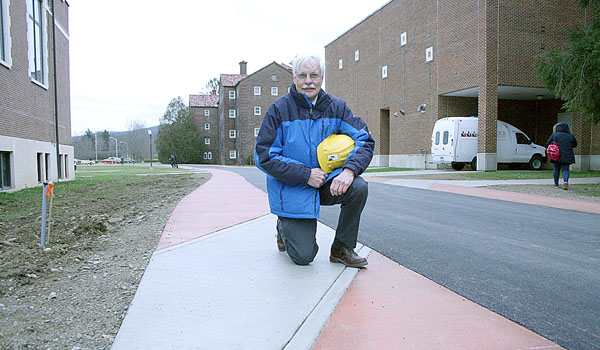Sidewalk design pays homage to Bonaventure Railroad
by KATIE FAULKNER
ST. BONAVENTURE — The sidewalk that runs between the Regina A. Quick Center for the Arts and Butler Memorial Hall at St. Bonaventure University has a new design that pays tribute to the university's history.
Philip Winger, associate vice president for facilities, took the opportunity to highlight the past existence of the St. Bonaventure Railroad during the recent installation of the sidewalk.
"Father Tom Plassmann's St. Bonaventure Railroad is a fun piece of our history," said Winger, referring to the university's 11th president who served from 1920 to 1949. "It represents a typically frugal solution to a problem: how to get coal to the boiler house in trying times."
In 1929, the Baldwin 0-4-0 engine first pulled onto the tracks of the St. Bonaventure Railroad. The 300-yard-long shortline railroad ran from the heating plant, around Devereux Hall to the east, and then across what is State Street today to connect to the Pennsylvania Railroad.
According to University Archives, Father Plassmann liked to say that his railroad may have been short, but "it was just as wide as any other."
The little engine operated on a tramline in Emporium, Pa., before coming to Olean for use in the Armour Meat Company tannery. It came to Bona's from the tannery in the 1930s. By 1940, the engine began deteriorating and was retired. The railroad continued to see use, with the Pennsylvania Railroad pushing coal cars up the track to the boiler room. Eventually, the tracks became too unstable for use and the college switched to trucks for the delivery of coal.
Upon creating the new sidewalk earlier this month, coal and other railroad remains were uncovered outside of the Quick Center for the Arts.
"We uncovered some relics of the railroad during our recent project and thought of bringing this piece of history to new generations," said Winger.
In order to honor this piece of Bonaventure history, Winger plans to create a historic marker sign to be placed near the new design element.




